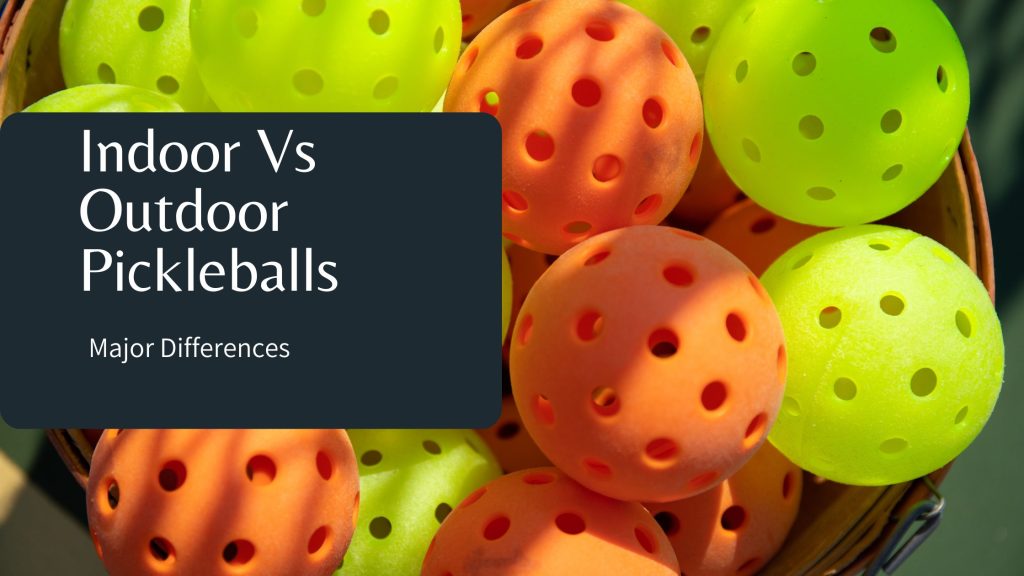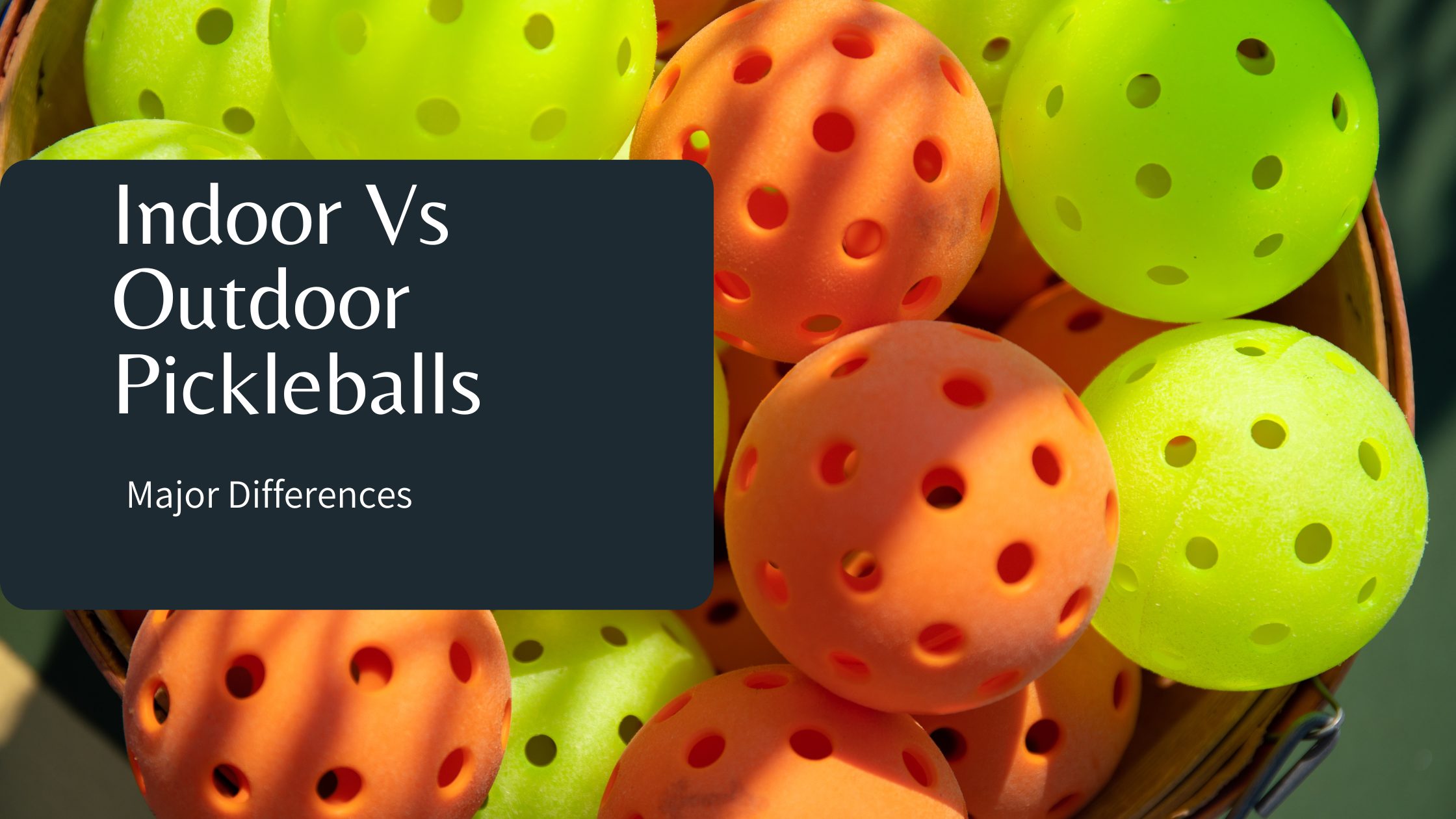
There is much discussion regarding the optimal choice for indoor Vs outdoor Pickleballs use. While both offer distinct advantages, it is important to be aware of the key differences between them in order to make an informed decision. This article will examine the peculiar qualities of indoor and outdoor pickleball balls so that you can select the best ball for your playing requirements. Let’s have a look at the types of pickleball first:
Types of Pickleball Balls
When it comes to balls for pickleball, there are two main types: indoor pickleballs and outdoor pickleballs. Each type of ball has its characteristics and advantages, so it’s important to know the differences before making a purchase.
1. Indoor Pickleballs
Indoor pickleballs are designed for, you guessed it, indoor play. They are usually yellow or green and have a hollow core. The core is filled with a polymer material or a combination of rubber and plastic. The cover also has a softer feel than outdoor pickleballs. Indoor pickleballs are designed for slower play and are great for beginners and those just starting out. They are also less likely to dent or pop when playing indoors.
2. Outdoor Pickleballs
Outdoor pickleballs, on the other hand, are better suited for outdoor play. They are typically bright yellow or orange and have a solid core made of polymer material. The cover is also firmer than indoor pickleballs.
Material For Indoor Vs Outdoor Pickleballs
When it comes to pickleball balls, many factors come into play, from the size and shape of the ball to the type of surface you are playing on. But one of the most important aspects to consider is the type of material used for the pickleball. Whether you’re playing indoors or outdoors, the material used for the ball can make a huge difference in your game. In this section,we’ll take a look at the differences between indoor and outdoor pickleballs and how the material affects your game.
Indoor pickleball is typically played on a wooden or hard court surface using a plastic or composite paddle. As such, indoor pickleballs must be made from a durable, low-bounce material that enables the ball to stay within the court bounds and provide a consistent bounce. The best pickleballs for indoors are usually made from a solid core surrounded by a soft outer layer. This combination ensures that the ball has a consistent, predictable bounce and that it won’t roll too far off the court when hit.
Outdoor pickleball, on the other hand, is usually played on a rubber or clay surface. The conditions of an outdoor court can vary depending on the weather, so it’s important to choose a pickleball with a medium-to-high bounce that can adapt to different court conditions. Outdoor pickleballs are usually made from a hard or medium-density core and a soft outer layer. This allows the ball to bounce higher than an indoor pickleball, but still maintain a consistent bounce regardless of court conditions.
No matter if you’re playing indoors or outdoors, having the right pickleball material is key to having a great pickleball game. If you’re new to pickleball, try out a few different models to find the one that works best for you and your playing style. With the right pickleball material, you’ll be sure to have a great game no matter which court you’re playing on.
Factors to Consider When Choosing a Pickleball Ball
Knowing what factors to consider when selecting a pickleball ball can help you choose the best one for your needs.
By considering these factors, you can select the perfect pickleball ball for your game. With the right ball, you can take your play to the next level and enjoy a more exciting and thrilling game!
Benefits Of Playing With An Indoor Balls
Here are three benefits of playing with an indoor ball:
| Slower Pace | Playing with an indoor ball allows for a slower pace. This can be beneficial for players who need time to think and strategize in order to make the most of their game. This slower pace can also help to prevent injuries due to rushed decisions and an over-excited game. |
| Easier to Control | Indoor balls are typically made with a softer material than outdoor balls, making them easier to control. This can help players make their shots with more accuracy, allowing them to truly practice their game. It’s also easier to control the ball indoors due to the lack of wind and other outside elements, such as rain or other weather patterns that can affect the speed and flight of the ball. |
| Less Bounce Variation | Indoor balls typically have less bounce variation than outdoor balls, which can be beneficial for those who need to practice their shots. When playing with an indoor ball, you know what kind of bounce you’ll be getting every time, making it easier to practice the same shot over and over. The lack of bounce variation also makes it easier to control the ball and keep it in the court. |
Benefits of Playing with an Outdoor Ball
People are discovering the amazing benefits of playing with an outdoor ball in pickleball. Here’s why:
| Faster Pace | Playing with an outdoor ball in pickleball results in a faster pace of play. The outdoor ball is slightly larger and heavier than the indoor ball, so it requires more power and energy to hit the ball. This means that the shots you hit are more unpredictable and require more skill and reaction time. This helps players improve their overall pickleball game, as it forces them to be quicker and more accurate. |
| Challenging in Control | When playing with an outdoor ball in pickleball, you’ll experience a greater challenge in controlling and accurately placing the ball. The outdoor ball is softer, more durable, and more resistant to wind and weather, so you’ll need to adjust your shots to account for the changing conditions. This gives you the opportunity to work on the accuracy of your shots and improve your control over the ball. |
| Greater Bounce Variation | With an outdoor ball in pickleball, you’ll experience a greater variation in the bounce of the ball. This is due to the effect of the wind and weather on the ball, which changes the trajectory and spin of the ball with each shot. This helps players develop a greater understanding of the physics of the game, as well as helping them to practice the timing of their shots. |
FAQs
Final Verdict
Now the question is which ball to choose and can you use indoor pickleballs outdoor? Or outdoor balls on an indoor court surface? The answer is Yes, you can play with any ball at any court by taking precautionary measures to avoid any circumstances. It is recommended to use the right ball on the right court to get the most professional look and enjoy the game to its fullest.
